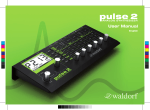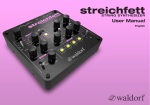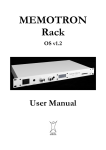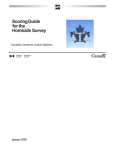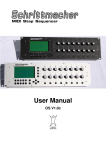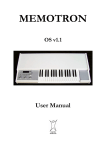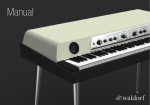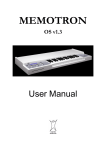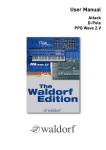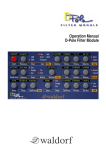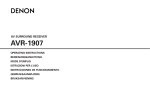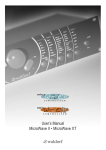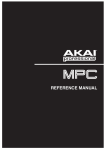Download Waldorf Rocket
Transcript
Foreword Foreword Thank you for purchasing the Waldorf Rocket synthesizer. You now own a very compact analog synthesizer with an extraordinary look and astonishing sound. We know that already and you will know soon too. You have our word! effort to ensure the information herein is accurate and that the manual contains no contradictory information. Waldorf Music extends no liabilities in regard to this manual other than those required by local law. What to read? This manual or any portion of it may not be reproduced in any form without the manufacturer's written consent. The biggest problem with any manual is to find a way to cover both the needs of an absolute expert and a beginner alike. There are people who read a manual cover to cover while others don’t even touch it. The latter is the worst choice, especially when the manual describes a Waldorf instrument. Waldorf Music GmbH, Landskroner Straße 52, D-53474 Bad Neuenahr, Germany If you do decide to read the following manual we can promise you a lot of fun while reading it and especially afterwards working with the Waldorf Rocket. Your Waldorf-team Hint Waldorf Music is not liable for any erroneous information contained in this manual. The contents of this manual may be updated at any time without prior notice. We made every Rocket User´s Manual 2 Foreword We would like to thank The Rocket Development Team Hardware: Oliver Rockstedt, Frank Schneider Software: Oliver Rockstedt, Stefan Stenzel, Wolfram Franke Design: Axel Hartmann Manual/ Layout: Holger Steinbrink Revision: 1.0, February 2013 w Karsten Dubsch, Willie Eckl, Joachim Flor, Michael von Garnier, Erik Heirman, Frédéric Meslin, Kurt "Lu" Wangard, 吴海彬, and anyone we have forgotten. Please visit our website http://rocket.waldorfmusic.de. It is possible a newer operating system is available as a download for your Rocket. 3 Rocket User´s Manual Content Content Setup and Connection ........................................................ 11 Foreword ................................................................................ 2 Package Contents .......................................................... 11 What to read? .................................................................. 2 Connections .................................................................. 11 Hint ................................................................................ 2 The Rocket Development Team ...................................... 3 The USB Connection ..................................................... 13 We would like to thank ................................................... 3 Basic Operation ................................................................... 14 Content ................................................................................... 4 Switching on/ off ............................................................ 14 System Volume .............................................................. 14 Control Features and Connections ...................................... 6 Where are the Presets? ................................................... 14 Front Panel ...................................................................... 6 Editing Parameters ......................................................... 14 The Launch Button ........................................................ 14 Connections .................................................................... 7 Introduction ............................................................................ 8 Sound Parameters ............................................................... 15 About this Manual ........................................................... 8 Symbols .......................................................................... 8 Highlighted Control Features and Parameters .................. 8 Overview of Functions ................................................... 15 Oscillator Section .......................................................... 15 VCF Filter Section .......................................................... 18 General Safety Guidelines ............................................... 9 Suitable Operating Conditions ........................................ 9 Power Supply .................................................................. 9 Operation ....................................................................... 9 Maintenance ................................................................. 10 Proper Use .................................................................... 10 Rocket User´s Manual Envelope Section (ENV) ................................................. 19 LFO/ ARP Section .......................................................... 21 Additional Functions ........................................................... 24 MIDI Channel Settings ................................................... 24 Sending and Receiving Sound Data ............................... 24 4 Content Sound Synthesis Basics ..................................................... 25 Glossary ......................................................................... 36 Oscillators Introduction ................................................. 25 Declaration of Conformity ............................................. 41 Filter Introduction .......................................................... 29 FCC Information (U.S.A.) ............................................... 43 Appendix .............................................................................. 31 Canada .......................................................................... 43 Updating the Firmware .................................................. 31 Other Standards (Rest of World) ..................................... 43 Issues during Firmware Upgrade Process ....................... 32 Product Warranty ........................................................... 44 Filter Calibration............................................................ 32 Product Support ............................................................. 44 Technical Data .............................................................. 33 MIDI Controller Numbers .............................................. 34 5 Rocket User´s Manual Control Features and Connections Control Features and Connections Front Panel Rocket User´s Manual 6 a Headphone Volume Dial b Oscillator Controls c Filter Controls d Launch Button/ MIDI Input Indicator e LFO/ Arpeggiator Controls f Envelope Controls Control Features and Connections Connections A MIDI Out Jack E Audio Line Output (Mono Jack) B MIDI Channel Selection Button 6 VCF Audio Line Input (Mono Jack) C MIDI In Jack 7 Stereo Headphone Jack D USB Port for power supply and connection to a suited computer 7 Rocket User´s Manual Introduction Introduction About this Manual Highlighted Control Features and Parameters This manual was written to help you become familiar with the Rocket synthesizer. It will also aid experienced users with routine tasks. All of the Rocket´s buttons, controls and parameters are highlighted in bold letters throughout the manual. Example: To avoid confusion, the terminology in this manual is based on the Rocket parameter names. You will find a glossary at the end of this manual; it explains the various terms used. Symbols w ☞ Caution – The comments that follow this symbol will help you avoid errors and malfunctions. Info – Additional information on a given topic. Instruction – Follow these guidelines to execute a desired function. ✻ Example – Real-world examples to try out. Rocket User´s Manual Press the Launch button. • Move the Cutoff knob. The Rocket’s different modes and parameter pages are illustrated in a depiction of the display. Important terms are highlighted in bold letters. m • 8 Introduction General Safety Guidelines Power Supply m • If not connected to a computer via USB, please use only the supplied USB power supply. • Unplug the device when you are not using it for longer periods. • Always pull the plug when unplugging the device, never the cable. Please read the following safety tips carefully! They include several precautions you should always observe when dealing with electronic equipment. Read all of the instructions before operating your device Suitable Operating Conditions • Use the device indoors only. Outside it could be rainy or humid as well as too hot or too cold. • Never use the device under damp conditions such as in bathrooms, washrooms or around indoor swimming pools. • Do not use the device in extremely dusty or dirty environments in order maintain the surface finishing of the Rocket. • Make sure that adequate ventilation is available on all sides of the device. Do not place the device near heat sources such as radiators. • Do not expose the device to direct sunlight, even if you have a suitable sunscreen. • Do not expose the device to extreme vibrations. Operation 9 • Never place objects containing liquids on or near the device. • Always place the device on a stable base only. • Make sure no foreign objects find their way into the chassis. If for some reason this should occur, switch the power off, unplug the device and consult a qualified repair center. • This device, used on its own or with amplifiers, speakers or headphones, can generate volume levels that may result in irreparable damage to your hearing and/or speakers and amplifiers. For this reason you should keep the volume at appropriate levels at all times. Rocket User´s Manual Introduction Maintenance • Do not open the device or remove the cover. Refer all service and repair tasks to qualified personnel. There are no user serviceable parts inside the chassis. • Use only a dry, soft cloth or brush to clean the device. Never use alcohol, cleaning solutions or similar chemicals. They will damage the surface of the chassis. Proper Use This device is designed exclusively to produce lowfrequency audio signals for the purpose of generating sound. Any other use is prohibited and voids the warranty extended by Waldorf Music. Waldorf Music is not liable for damages due to incorrect use. m Do not leave your Rocket near children, mothersin-law or pets. This could lead to critical interactions. Rocket User´s Manual 10 Setup and Connection Setup and Connection Connections Package Contents • the Waldorf Rocket Synthesizer • an external USB power supply as well as an USB cable In order to get started with your Rocket you will need an AC power outlet or a suitable computer with an USB port. For the connection of the audio output you will need either a mixing console or an audio interface. You can also use a suitable headphone. Last but not least you will mostl likely need a MIDI master keyboard. • a CD-ROM with the complete PDF manual and other tools You can also use a computer or hardware sequencer to make use of the Rocket’s MIDI features. The Waldorf Rocket package comes complete with: w ☞ You own a computer without a CD drive? Don´t worry, you can download all necessary data here: http://rocket.waldorfmusic.de To connect the devices: 1. Turn all units off. 2. Connect the Rocket´s audio output 3 to your mixing console or your computer audio interface. Optionally connect a suited stereo headphone to the Rocket´s headphone output 1. Please ensure all the items above are included. If something is missing, contact your local dealer. We recommend that you keep the original packing material for future transport. 3. To play the Rocket you need a MIDI master keyboard. Connect its MIDI Out jack to the Rocket´s MIDI input 5. 11 Rocket User´s Manual Setup and Connection w 4. If you want to use a computer with a MIDI interface, connect your interface´s MIDI Out jack to the Rocket´s MIDI In jack 5. 5. Optionally you can connect the Rockets´s USB port 4 with a USB cable to your computer. After that the Rocket is automatically available as a MIDI unit and will also receive power via the USB connection. w 6. Without a computer, you need to connect the USB power supply that came with the Rocket to the USB port 4 of the Rocket. After that, the Rocket is ready for work! m 7. If you want to use the external filter input, please connect it 2 to a line output of your signal source. 8. Then switch on the computer (if connected), the mixing console and finally the amplifier or active monitor speakers. Rocket User´s Manual 12 To check the correct reception of MIDI data send any MIDI event to the Rocket; the Launch button LED b will light up on any incoming MIDI message. If this is not the case please check the MIDI connection to the Rocket. By default, the Rocket will receive MIDI data on MIDI channel 1. If you do not choose to connect a mixing console, you can patch the Rocket’s output signals directly to an amp or an audio interface. Use an input usually called Line, Aux or Tape input Before connecting and disconnecting the Rocket to a power supply source, turn your amp’s volume control all the way down to avoid damage due to on/off switching noise. The Rocket produces a high level output signal. Please take care that the connected playback device is suitable for the high level of an electronic instrument. Never use the mic or phono input of the connected amp! w The USB Connection Using a USB cable you can connect the Rocket to your computer observing the following system requirements: • Windows PC: Windows XP or newer is recommended, a USB port • Linux PC, a USB port • Apple: Intel Mac with Mac OS X 10.5 or newer, a USB port Keep also in mind that we offer new firmware updates from time to time. Please read also the chapter "Updating the Firmware". The USB connection of the Rocket allows • Power supply via USB without using an additional power supply when connected to a suitable computer • Power supply via the USB power supply • transmitting and receiving MIDI data • dumping of firmware updates to the Rocket • data exchange with suitable computer software w Make sure to use a suited computer USB port as well as a USB suited cable to avoid problems with data transmission. 13 Rocket User´s Manual Basic Operation Basic Operation Editing Parameters Switching on/ off In order to edit a sound, you must access the appropriate parameters. In spite of the Rocket’s compactness it uses a sophisticated user interface allowing fast editing of any parameter. The Rocket is ready-to-operate after the connection to the USB power supply or via USB cable to a suitable computer. Turning a dial clockwise increases the corresponding value; turning it counterclockwise decreases it. Unbelievable! Switching a switch does exactly switch this switch. Keep in mind, that some switches offers more than two states. System Volume What do you know? The Headphone Volume knob a controls the Rocket’s headphone volume The main audio output always delivers a line level signal. The Launch Button A short tip on the Launch button sends out MIDI note C3 (MIDI note number 60). Use this button in case no MIDI keyboard is connected. Where are the Presets? Presets are absent by design. Because of the very clear controls we can assure you that you will be able to set an universe of sounds within seconds. w w Take a look at page 24 of this manual. Here you will learn how to save sound parameters to your computer. Incoming MIDI data is indicated by blinking of the Launch LED. w Rocket User´s Manual The Launch button memorizes the last note received via MIDI and will use it for further triggering until a new MIDI note arrives. 14 Another function of the Launch button will be explained on page 24 of this manual. Sound Parameters Sound Parameters • Overview of Functions The Waldorf Rocket consists of numerous sound-shaping components w Modulators: The Modulators are designed to manipulate or modulate the sound generating components to add dynamics to the sound. The Low-frequency Oscillator (LFO) is designed for periodic or recurring modulations while the Envelope is normally used for modulations that occur once. Oscillator Section (OSC) Is the Rocket your first synthesizer? Are you curious about sound synthesis? If so, we recommend to read the chapter "Sound Synthesis Basics" in this manual. It looks like the Rocket offers only a single oscillator. But there is more to know and more to hear. You should know that the Rocket consists of two different types of components for sound generation and sound shaping: • Sound synthesis: Oscillator, Filter, Amplifier with saturation: These modules represent the audio signal flow. Sound generation actually occurs within the Oscillator. It produces square and sawtooth waves. The Filter then shapes the sound by amplifying (boosting) or attenuating (dampening) certain frequencies. The Amplifier is located at the end of the signal chain. It setss the overall volume of the signal and can add some saturation. w 15 A detailled introduction to oscillators can be found in the chapter "Sound Synthesis Basics". Rocket User´s Manual Sound Parameters sawtooth waves. This feature is for fat poly saw cluster sounds. Pulse/ Saw The Osc Switch Sets the type of waveform generated by the Oscillator: • Pulse selects the pulse waveform. A Pulse waveform with a pulsewidth of 50% has only the odd harmonics of the fundamental frequency present. This waveform produces a hollow/ metallic sound. • Saw selects the sawtooth waveform. A Sawtooth wave has all the harmonics of the fundamental frequency in descending magnitude. Wave • Tune diverse functions • Saw Sync Mode: This mode is active if the Osc switch is set to Saw and the Wave knob is in the first half. It is indicated in green colour on both knobs. Within the range from leftmost to center position you can control the sync envelope time from infinity (∞) to quite short values. Within the range from center position to rightmost you can add up to eight Rocket User´s Manual diverse functions This parameter offers different functions based on the knob position: This parameter offers different functions based on the knob position. • If Pulse is selected: From leftmost to center position, the pulsewidth can be adjusted from 0 to 50%. Note that a pulswidth of zero results in silence, which can be useful if you want to use the audio input. A pulsewidth of 50% is also known as square wave, which consists of only odd harmonics and produces a hollow/ metallic sound. From center to rightmost position you can set a pulse width modulation. First with adjustable depth, further on with increasing speed. 16 If Saw is selected and the Oscillator sync mode is active (Wave has to be set between leftmost and center position): Here the start frequency of the sync slave oscillator is set. It will go down to the frequency of the master within the time set by the Wave knob. Sound Parameters • • • position to rightmost you can control the pitch of the pulse oscillator in a musical range. If Saw is selected and the Wave knob is in the exact center position, a single sawtooth is generated. If the Wave knob is increased further, the sound is enriched by more sawtooth oscillators up to a maximum of eight oscillators. Within the range of leftmost to center position you can control the amount of detune of the poly saw oscillators in cents. Within the range of center position to rightmost you can create predefined musical intervals and chords. w Pitch Bend uses a value range of +/- 12 semitones. Glide "Glide" or "Portamento" describes the continuous gliding from one note to another. This effect can be created on fretless stringed instruments or some brass instruments. It is very common on synthesizers and used throughout all music styles. Please note that Glide only works, if you play the Rocket legato. Special case Unison Mode: This special mode is active, if Saw is selected and both Tune and Wave knobs are in their rightmost position. In unison mode, all eight sawtooth oscillators sound with frequencies according to the held notes. So if you play a chord with up to eight notes, that chord is played by the oscillators. If you play a single note, all eight oscillators play this note, slightly detuned to enrich the sound. Note that this is not yet polyphony because individual envelopes and filters are missing, but it allows you to play chords nevertheless. w Dear friend of electronic club music: Use Glide to produce a typical pitch bass and pitch lead sound. Glide sets the glide time. Low settings will give a short glide time in a range of milliseconds that gives a special character to the sound. Higher settings will result in a long glide time of up to several seconds which can be useful for solo and effect sounds. In the leftmost setting, the Glide function is deactivated. If Pulse is selected: Within the range from leftmost to center position you can control the detune of the pulse oscillator in cents. Within the range of center w 17 If the Arpeggiator is selected, Glide is controlled by the selected arpeggiator pattern. Rocket User´s Manual Sound Parameters VCF Filter Section The HP Highpass is useful to thin out a sound’s bass frequencies. It cuts frequencies below the cutoff point. • Keytrack Off / 50% / 100% Sets how much the cutoff frequency depends on the MIDI note number. The reference note for Keytrack is C3, note number 60. The Rocket offers a multimode filter. w Cutoff A detailed introduction of the filters can be found in the chapter "Sound Synthesis Basics" of this manual. Type Cutoff the frequency for the lowpass and highpass filter type and the center frequency for the band pass. LP / BP / HP • When the lowpass type is selected via the Type switch, all frequencies above the cutoff frequency are damped. • When the highpass type is selected, all frequencies below the cutoff frequency are damped. • When the bandpass type is selected, only frequencies near the cutoff setting will be passed through. Selects the filter type: • The LP Lowpass cuts frequencies above the cutoff point. • The BP Bandpass cuts frequencies both below and above the cutoff point. As a result, the sound character gets thinner. Use these filter types when programming effect and percussionlike sounds Rocket User´s Manual 18 Sound Parameters You can bring more movement into the sound by modulating the cutoff frequency via the LFO, the envelope or the Keytrack parameter of the filter. At center position (100% Keytracking) and maximum Resonance level, the then self-oscillating filter can be played in a tempered scale. attack usually have a envelope amount that makes the start phase bright and then closes the filter to get a darker sustain phase. By the way, the envelope amount also depends on the played velocity. Use this feature to give a more expressive character to the sound. When you hit the keys smoothly, only minimal modulation is applied. When you hit them harder, the modulation amount also gets stronger. Resonance Resonance is the emphasis around the corner frequency. Use lower values to give more brilliance to a sound. At higher values a sound gets the typical filter character with a strong boost around the cutoff frequency. When the setting is raised to maximum, the filter starts to self-oscillate, generating a pure sine wave. This feature can be used to create analog-style effects and percussion, like electronic toms, kicks, zaps etc. w If you want to process an external audio signal by the Rocket´s filter, you should set the OSC switch to Pulse and the Wave knob to minimum. Envelope/Boost Section (ENV) Env Mod (= Envelope Mod Amount). Sets the amount of influence the envelope has on the cutoff frequency. For higher settings, the filter cutoff frequency is increased by the modulation of the envelope. Use this parameter to change the timbre of the sound over time. Sounds with a hard The Rocket offers two envelopes for filter and volume. Both envelopes are using the same Decay and Release settings. The filter envelope is using Decay/ Release 19 Rocket User´s Manual Sound Parameters without a Sustain phase while the amplifier envelope offers a switch for Sustain. Everytime a note comes in, both envelopes are triggered with an Attack rate of zero Boost Release If Release is set to on, the envelope will fade to zero using the Decay rate when the note is stopped. Otherwise the envelope stops with a decay rate of zero, which results in immediate silence on / off Boost saturates the signal. If set to off, no saturation will be added or, in other words, the signal will remain clean. If set to on, harmonics will be added to the signal, resulting in a warm distorted character, suitable for harder lead sounds and effects. For your information: The saturation stage is located behind the filter module. ✻ Decay Decay is the rate used for the envelope to go down to zero according to both Sustain and Release settings. Boost is well suited for sounds that use some filter resonance. Sustain w on / off If Sustain is set to on, the envelope will remain at the maximum level as long as the note is played. Otherwise it will fade towards zero with a rate according to Decay. Rocket User´s Manual on / off 20 If both Sustain and Release are set to "on", the envelope will not be retriggered when the pitch changes because one key has been released. Otherwise the envelope will always be triggered whenever pitch changes. Keep this in mind when experimenting with the Arpeggiator, as it can produce surprising results. Sound Parameters The Launch Button More about this button can be found in the chapter "Basic Operation". LFO/ ARP Section In addition to the main oscillator, the Rocket is equipped with a low frequency oscillator (LFO) that can be used for modulation purposes. The LFO generates a periodic waveform with adjustable frequency and shape. Alternatively this section offers an Arpeggiator that splits incoming MIDI chords into its single notes and repeats them rhythmically. w Hint: The Modulation Wheel of your MIDI master keyboard can be used to control the vibrato intensity with an additional internal LFO. You can change the speed of this LFO by using MIDI CC# 80. The Target Switch OSC / VCF /ARP Sets the modulation destination for the LFO. Also activates the Arpeggiator. 21 • OSC selects oscillator pitch as the destination for the LFO modulation. The Arpeggiator is inactive in this position. • VCF selects the filter cutoff as the destination for the LFO modulation. The Arpeggiator is automatically deactivated in this setting. Rocket User´s Manual Sound Parameters • w w as original. Higher settings mean that the note list is repeated in higher or lower octaves. ARP activates the Arpeggiator. The LFO is automatically deactivated in this setting. From center to rightmost position, eight rhythmic patterns can be selected. If the Arpeggiator is selected, Glide is controlled by the selected arpeggiator pattern. The Shape/ Direction Switch Aftertouch (if your MIDI master keyboard is able to send this data) is always routed to filter cutoff. Depth/ Range This switch offers two modes depending on whether LFO or Arpeggiator is active. Diverse This knob offers two modes depending on whether LFO or Arpeggiator is active. If LFO is selected, the switch sets the LFO waveform: When LFO is active, the knob controls the modulation depth for the selected LFO modulation. The basic principle: The higher the values, the more intensive the LFO modulation. w Exception: If oscillator pitch is modulated, settings between center and rightmost position will vary the modulation depth in semitones. • The Square shape can be interesting for hard changes and special effects. • The Triangle shape is perfect for smooth pitch or filter modulations. • The Saw (downwards) shape can generate interesting filter changes. w When ARP mode is active, you can set the range of notes in octaves with settings from leftmost to center position. You can select up to 4 octaves. When it is set to 1 Octave, the note list will be played back in the same octave Rocket User´s Manual Square / Triangle / Sawtooth / Diverse 22 For your information: Oscillator pitch modulation by the LFO Square shape is unipolar. It oscillates in only one direction. Sound Parameters When ARP is selected, the switch sets the direction that is used to play back the arpeggio: • • • In LFO mode: Speed sets the frequency of the LFO. At low settings, it might take several minutes for the LFO to perform a complete cycle while higher settings are up to the audible range (from 0.05 Hz to 50 Hz). The center position is about 1 Hz. When MIDI clock is received, you can adjust Speed in musical values (e.g. 1/4) in reference to the frequency. If Up is selected, the note list is played forward and the octaves are transposed upward. The arpeggio starts in the original octave and goes up to the highest octave. Then the arpeggio is repeated. w If Alternate is selected, the note list is first played backward and the octaves are transposed downward. The arpeggio starts in the highest octave. After reaching the first note of the note list in the original octave, the note list is played forward and the octaves are transposed upward up to the last note of the note list in the highest octave to play. Then the arpeggio is repeated. When Speed is turned fully counter-clockwise, the LFO stops and each note generates a random output value. In ARP mode: Speed sets the speed of the arpeggiator in BPM with 1/8th note steps. The range goes from 24 up to 600 BPM. When external MIDI clock is received, you can adjust Speed in musical values (e.g. 1/4) in reference to the frequency. w If Random is selected, the note list is played randomly. w Speed This knob offers two modes depending on whether LFO or Arpeggiator is active. 23 When external MIDI clock becomes inactive, LFO / Arp will remain on last Speed value until another speed is set. By the way: The LED above the Speed knob is pulsating rhythmically to the LFO frequency. If in Arp mode, the LED will be blinking when arpeggiator notes are generated. Rocket User´s Manual Additional Functions ☞ Activation of the sound dump function: Additional Functions • To send the data, press and hold the Launch button for around one second. • The corresponding MIDI controller data will automatically be sent and can be easily recorded. MIDI Channel Settings By using the MIDI Channel Selection button 6 on the Rocket´s backside you can simultaneously set the desired MIDI transmitting as well as receiving channel: • Press and hold the MIDI Channel Selection button. • Send any MIDI note from your MIDI master keyboard. The Rocket will identify the MIDI channel of the sending device and set it as its own receiving and transmitting channel. w ☞ Receiving a sound dump: Sending and Receiving Sound Data • The sound dump function lets you send the actual sound parameter data of the Rocket via MIDI or USB. Send the recorded MIDI controller data to the Rocket. The sound data will be automatically resumed. w After activation, all sound parameters of the Rocket are sent as MIDI controller data to a connected computer. Here you can record this data with a suitable software, e.g. a sequencer application. Rocket User´s Manual If you are working with the Rocket in a recording studio, we recommend to save the actual sound data at the beginning of the Rocket MIDI track. This enables you to hear the right Rocket sound in your music production. w 24 Keep in mind: If sending sound data to the Rocket, all actual sound parameter edits will be lost. The following parameters can not send MIDI Controller data: Headphone Volume, Filter Type switch, Boost switch and the Launch button. Sound Synthesis Basics nitude of each harmonic descends by the factor of its position. This means that the first harmonic (the fundamental) has full magnitude, the second harmonic has half magnitude, the third harmonic has a third magnitude and so on. The following picture shows how the individual harmonics build up the sawtooth wave: Sound Synthesis Basics Oscillators Introduction The oscillator is the first building block of a synthesizer. It delivers the signal that is transformed by all other components of the synthesizer. In the early days of electronic synthesis, engineers found that most real acoustic instrument waveforms can be reproduced by using abstracted electronic versions of these waveforms. They weren´t the first who came to that conclusion, but they were the first in recreating them electronically and building them into a machine that could be used commercially. What they implemented into his synthesizer were the still wellknown waveforms sawtooth and square. For sure, this is only a minimal selection of the endless variety of waveforms, but the Waldorf Rocket gives you exactly these waveforms at hand. Now, you probably know how these waveforms look and sound, but the following chapter gives you a short introduction into the deeper structure of these waveforms. The Sawtooth Wave The Sawtooth wave is the most popular synthesizer waveform. It consists of all harmonics in which the mag- 25 Rocket User´s Manual Sound Synthesis Basics back to its original position. The bow is still moved and so it catches the string again and the procedure is repeated. The result is a waveform that looks like a sawtooth. The same is true for a brass instrument. The string in this case are the lips while the bow is the air. The lips are moved by the air to a certain extent and abruptly move back to their original position. !;2<=/'5>+1, ./0+12*3(<! 9 $+3<=/'5>+1, ./0+12*3(<!?$ 9 The Square Wave @'3<=/'5>+1, ./0+12*3(<!?@ The Square Wave is a pulse waveform with 50% pulse width. This means that the positive part of the waveform has the same length as the negative part. The pulse waveform can have other pulse widths as you will read later. For now, we´ll talk about the square wave as a unique waveform. The square wave consists of all odd harmonics in which the magnitude of each harmonic descends by the factor of its position. This means that the first harmonic has full magnitude, the third harmonic has a third magnitude, the fifth harmonic has a fifth magnitude and so on. The following picture shows how the individual harmonics build up the pulse wave: 9 "2A<=/'5>+1, ./0+12*3(<!?" 657812*3( 9 B B : ./0+12*3( 415( ! " # !$ =/'5>+1,; !% &'()*(+,- Additive components of the Sawtooth wave The sawtooth wave was thought as an abstraction of the timbre of string and brass instruments. You can easily understand that when you think of a violin. Imagine a bow pulling the string slightly into one direction. At one point, the string abruptly comes off the bow and swings Rocket User´s Manual 26 Sound Synthesis Basics The Pulse Wave !;2<=/'5>+1, ./0+12*3(<! The Pulse Wave is the most versatile wave in a classic synthesizer because its shape and therefore its harmonic content can be changed in real time. This is done by changing the width of the upper and lower portion of the waveform cycle. These portions are called pulses, hence the name pulse width. The width of the first pulse is used to distinguish between different pulse waves and it is measured in percent. The following picture shows several pulse waves with different pulse widths: 9 "'3<=/'5>+1, ./0+12*3(<!@" 9 #2?<=/'5>+1, ./0+12*3(<!@# 9 $2?<=/'5>+1, ./0+12*3(<!@$ 657812*3( 9 A A : ./0+12*3( 415( ! " # $ % !! !" !# =/'5>+1,; &'()*(+,- Additive components of the square wave with 50% pulse width 27 Rocket User´s Manual Sound Synthesis Basics very symmetrical harmonic content, while all other pulse widths create peaks or troughs at certain frequencies. Another special case is a pulse wave with a very narrow pulse width, in the above picture labelled as <1%. An infinitely thin pulse creates a spectrum that has all harmonics with equal magnitudes. In a digital synthesizer, "infinitely" necessarily means one sample. #&'()*+,./0*12-(314-5 ! " # $ % !! !" !# ""'()*+,- ! " # $ % !! !" !# The pulse wave is an artificial wave, which means that it doesn’t occur in nature. It was built into synthesizers because it can create a lot of different timbres with a minimum of technical effort. However, certain pulse widths sound very close to the timbres of acoustic (or semi-acoustic) instruments, i.e. a guitar or bass guitar, an e-piano or even a flute. 6#'()*+,- ! " # $ % !! !" !# 7!'()*+,.89:*+,-5 ! " # $ The most powerful feature of the pulse wave is the ability to change its width while sounding. This is called pulse width modulation. When the pulse width is changed, the waveform starts to sound thicker. This happens because the effect is very similar to what you hear when you have two oscillators running with slightly different frequencies. They interfere and create irregular troughs in the resulting waveforms. % !! !" !# Additive components of Pulse wave with different pulse widths The first fact you can probably observe is that the lower part of the wave has a narrower excursion. This is because the energy of the wider pulse is higher than the one of the narrower pulse. If this were not compensated, the overall signal would have an unwanted DC offset. As you have read in the previous chapter, the harmonic content of a 50% pulse wave is a special case. It has a Rocket User´s Manual 28 Sound Synthesis Basics )#*#+ Filter Introduction Once the audio signal leaves the oscillator, it is sent to the filter. The filter is a component that has significant influence on the Rocket’s sound characteristics. For now, we’ll explain the basic function of a filter discussing the type used most commonly in synthesizers: the low pass filter The low pass filter type dampens frequencies above a specified cutoff frequency. Frequencies below this threshold are hardly affected. The frequency below the cutoff point is called the pass band range, the frequencies above are called the stop band range. The Rocket’s filter dampens frequencies in the stop band with a certain slope. The following picture shows the basic principle of a low pass filter: !"#$%#&'( ,%-.// The Rocket’s filter also features a resonance parameter. Resonance in the context of a low, band or high pass filter means that a narrow frequency band around the cutoff point is emphasized. The following picture shows the effect of the resonance parameter on the filter’s frequency curve: 29 Rocket User´s Manual Sound Synthesis Basics )#*#+ 0#1.&2&'# !"#$%#&'( ,%-.// If the resonance is raised to a great extent, then the filter will begin to self-oscillate, i.e. the filter generates an audible sine wave even when it does not receive an incoming signal. Rocket User´s Manual 30 Appendix Appendix • Make sure that any Cycle or Loop mode is switched off. Also make sure that any Metronome clicks and MIDI Clock are switched off. • Start the sequencer playing the file, and send the track data to the Rocket. The Launch button will blink rapidly during this procedure. • After the file is received correctly, the Rocket burns the new firmware into its Flash memory. Updating the Firmware The Rocket has a service-friendly feature that makes it possible to update the system software without changing any parts. All firmware updates come in the form of a standard MIDI file that can be read by nearly any sequencer. The fastest way to get this file is by downloading it from our web site at: w http://rocket.waldorfmusic.de w ☞ Possibly there will be a .zip file containing the new firmware as well as a manual addendum. w Updating Rocket’s firmware: • • Load the respective Standard MIDI File into your sequencer. Follow the instructions from your sequencer’s manual. m The MIDI file consists of one single track with several sysex messages in it. Make sure that this track is assigned to the Rocket so that it can receive the data. 31 You can perform a firmware update only via the USB connection. After a successfull firmware update, the Rocket may perform an automatical filter calibration. Reduce the volume of your audio system to avoid damage. Don´t disconnect the Rocket and computer during firmware upgrade process. If this happens, please read the next chapter. Rocket User´s Manual Appendix Issues during Firmware Upgrade Process • Switch Boost to off. If you have any problems during firmware upgrade process, please proceed as follows: • Send the MIDI tune request 0xF6 with a suited MIDI software to the Rocket. • Calibration progress can take up to 30 seconds. The Launch button LED will light up in a dimmed mode while calibration is in progress. • Disconnect the Rocket from the USB connection. • Press and hold the MIDI Channel Selection button 6 of the Rocket. • Reconnect the USB connection of the Rocket. This starts the Bootloader mode automatically. • Send the firmware again. Follow the instructions of the previous chapter. Filter Calibration The analog filter of the Rocket is calibrated at the factory. Tuning is very stable over a wide temperature range, so it is not necessary to use this function frequently: • The Rocket will generate high-volume output during calibration, so turn headphones volume down as well as the volume of your speakers or alternatively disconnect the audio output. • Disconnect anything connected to the VCF input. • Switch Filter Type to LP. Rocket User´s Manual 32 Appendix Technical Data Power Supply Maximum current consumption: 500 mA Dimensions and Weight Width: 185 mm Depht: 185 mm Height (including knobs): Total weight: 65 mm 0,9 kg Factory Settings MIDI Receive Channel 1 MIDI Transmit Channel: 1 33 Rocket User´s Manual Appendix MIDI Controller Numbers The following controls can not send MIDI Controller data: Headphone Volume, Filter Type switch, Boost switch and the Launch button. Ctrl 1 Alt Ctrl 1 70 79 31 33 29 31 Control- Controller or le Range Sound Parameter 0…127 Modulation Wheel 0…127 Osc Wave 0…127 Osc Tune 0…127 Osc Shape 74 71 73 83 69 70 73 72 0…127 0…127 0…127 0…127 Cutoff Resonance Env Mod Keytrack 76 77 78 16 50 15 0…127 0…127 0…127 LFO Speed LFO Depth LFO Shape Rocket User´s Manual Value Range 0…127 0…127 0…127 0: Saw, 1: Pulse 0…127 0…127 0…127 0: off, 1: half, 2: full 0…127 0…127 0: Saw down, 1: Tri, 2: Pulse 80 18 18 80 0...127 0…127 75 103 72 5 14 12 13 102 103 106 5 14 12 13 0…127 0…127 0…127 0…127 0…127 0…127 0…127 64 120 64 0…127 121 122 123 34 Vibrato Mod LFO LFO Target 0...127 0: Arp, 1: Cutoff, 2: Pitch ENV Decay 0…127 ENV Sustain 0: off, 1: on ENV Release 0: off, 1: on Glide 0…127 Arp Tempo 0…127 Arp Range 0…127 Arp Direction 0: random, 1: alt, 2: up Sustain Pedal 64 = on All Sound Off immediate silence Reset All Control- Resets Mod lers Wheel, Sust. Pedal, Aftertouch, Pitch Bend Local Control 0: off, 127: on All Notes Off releases all voices Appendix w The standard controller assignment can be found in the column "Ctrl #", the alternative assignment in the column "Alt Ctrl#". This alternative assignment can be used by sending a SysEx command to the Rocket. It enables you to use the Rocket as controller for other Waldorf synthesizer, e.g. the Blofeld. The Rocket SysEx documentation can be found here: http://rocket.waldorfmusic.de 35 Rocket User´s Manual Appendix and the clock, which means the repetition interval. Some arpeggiators also feature preset or programmable rhythm patterns. Glossary Aftertouch The majority of contemporary MIDI keyboards are capable of generating aftertouch messages. On this type of keyboard, when you press harder on a key you are already holding down, a MIDI Aftertouch message is generated. This feature is used to control the Cutoff frequency of the Rocket. Band Pass Filter Amount MIDI messages enable you to manipulate the response of a sound generator to a significant degree. A band pass filter allows only those frequencies around the cutoff frequency to pass. Frequencies both below and above the cutoff point are damped. Control Change (Controllers) Describes to which extent a modulation influences a given parameter. This message essentially consists of two components: • The Controller number, which defines the element to be influenced. It can be between 0 and 120. Amplifier An amplifier is a component that influences the volume level of a sound via a control signal. This control signal is often generated by an envelope or an LFO. • The Controller value, which sets the extent of the modification. Controllers can be used for effects such as slowly swelling vibrato and influencing filter frequency. Arpeggiator An arpeggiator is a device that splits an incoming chord into its single notes and repeats them rhythmically. Most arpeggiators feature different sequence modes to cover a wide range of applications. Typical controls for an arpeggiator are the octave range, the direction, the speed Rocket User´s Manual Decay "Decay" describes the descent rate of an envelope once the Attack phase has reached its zenith and the envelope drops to the level defined for the Sustain value. 36 Appendix frequency. A high pass filter in turn dampens the frequencies below the cutoff. The band pass filter allows only those frequencies around the cutoff frequency to pass, all others are dampened. A band stop filter does just the opposite, i.e. it dampens only the frequencies around the cutoff frequency. The most common type is the low pass filter. Envelope An envelope is used to modulate a sound-shaping component within a given time frame so that the sound is changed in some manner. For instance, an envelope that modulates the cutoff frequency of a filter opens and closes this filter so that some of the signal's frequencies are filtered out. An envelope is started via a trigger, usually a fixed trigger. Normally, the trigger is a MIDI Note. The classic envelope consists of four individually variable phases: Attack, Decay, Sustain and Release. This sequence is called an ADSR envelope. Attack, Decay and Release are time or slope values, and Sustain is a variable volume level. Once an incoming trigger is received, the envelope runs through the Attack and Decay phases until it reaches the programed Sustain level. This level remains constant until the trigger is terminated. The envelope then initiates the Release phase until it reaches the minimum value. Filter Cutoff Frequency The filter cutoff frequency is a significant factor for filters. A low pass filter dampens the portion of the signal that lies above this frequency. Frequencies below this value are allowed to pass through without being processed. High Pass Filter A high pass filter dampens all frequencies below its cutoff frequency. Frequencies above the cutoff point are not affected. Filter LFO A filter is a component that allows some of a signal's frequencies to pass through it and dampens other frequencies. The most important aspect of a filter is the filter cutoff frequency. Filters generally come in four categories: low pass, high pass, band pass, and band stop. A low pass filter dampens all frequencies above the cutoff LFO is an acronym for low-frequency oscillator. The LFO generates a periodic oscillation at a low frequency and features variable waveshapes. Similar to an envelope, an LFO can be used to modulate a sound-shaping component. 37 Rocket User´s Manual Appendix MIDI Thru has a special function. It allows the sender to transmit to several receivers. It routes the incoming signal to the next device without modifying it. Another device is simply connected to this jack, thus creating a chain through which the sender can address a number of receivers. Of course it is desirable for the sender to be able to address each device individually. Consequently, there is a rule which is applied to ensure each device responds accordingly. Low Pass Filter Synthesizers are often equipped with a low pass filter. A low pass filter dampens all frequencies above its cutoff frequency. Frequencies below the cutoff point are not affected. MIDI The acronym MIDI stands for "musical instrument digital interface." It was developed in the early 1980s so that diverse types of electronic musical instruments by different manufacturers could interact. At the time a communications standard for heterogeneous devices did not exist, so MIDI was a significant advance. It made it possible to link all devices with one another through simple, uniform connections. MIDI Channel This is a very important element of most messages. A receiver can only respond to incoming messages if its receive channel is set to the same channel as the one the sender is using to transmit data. Subsequently, the sender can address specific receivers individually. MIDI Channels 1 through 16 are available for this purpose. Essentially, this is how MIDI works: One sender is connected to one or several receivers. For instance, if you want to use a computer to play the Rocket, then the computer is the sender and the Rocket acts as the receiver. With a few exceptions, the majority of MIDI devices are equipped with two or three ports for this purpose: MIDI In, MIDI Out and in some cases MIDI Thru. The sender transfers data to the receiver via the MIDI Out jack. Data are sent via a cable to the receiver's MIDI In jack. Rocket User´s Manual MIDI Clock The MIDI Clock message sets the tempo of a piece of music. It serves to synchronize processes based on time. Modulation A modulation influences or changes a sound-shaping component via a modulation source. Modulation sources include envelopes, LFOs or MIDI messages. The modula- 38 Appendix tion destination is sound-shaping component such as a filter or a VCA. lope's current status. For instance, the Release phase may be initiated during the Attack phase. Note on / Note off Resonance This is the most important MIDI message. It sets the pitch and velocity of every generated note. The time of arrival is simultaneously the start time of the note. Its pitch is derived from the note number, which lies between 0 and 127. The velocity lies between 1 and 127. A value of 0 for velocity is similar to "Note Off". Resonance is an important filter parameter. It emphasizes a narrow bandwidth around the filter cutoff frequency by amplifing these frequencies. This is one of the most popular methods of manipulating sounds. If you substantially increase the resonance, i.e, to a level where the filter begins self-oscillation, then it will generate a relatively clean sine waveform. Pitchbend Sustain Pitchbend is a MIDI message. Although pitchbend messages are similar in function to control change messages, they are a distinct type of message. The reason for this distinction is that the resolution of a pitchbend message is substantially higher than that of a conventional Controller message. The human ear is exceptionally sensitive to deviations in pitch, so the higher resolution is used because it relays pitchbend information more accurately. An envelope parameter. The term "Sustain" describes the level of an envelope that remains constant after it has run through the Attack and Decay phases. Sustain lasts until the trigger is terminated. System Exclusive Data System exclusive data allow access to the heart of a MIDI device. They enable access to data and functions that no other MIDI messages are able to address. "Exclusive" in this context means that these data pertain only to one device type or model. Every device has unique system exclusive data. The most common applications for SysEx Release An envelope parameter. The term "Release" describes the descent rate of an envelope to its minimum value after a trigger is terminated. The Release phase begins immediately after the trigger is terminated, regardless of the enve- 39 Rocket User´s Manual Appendix data include transfer of entire memories and complete control of a device via a computer. Trigger A trigger is a signal that activates events. Trigger signals are very diverse. For instance, a MIDI note or an audio signal can be used as a trigger. The events a trigger can initiate are also very diverse. A common application for a trigger is its use to start an envelope. USB The Universal Serial Bus (USB) is a serial bus system to connect a computer with an external device. USB equipped devices can be plugged together while active. The recognition is made automatically. Volume The term describes a sound's output level Rocket User´s Manual 40 Appendix The following standards have been used to declare conformity: EG Konformitätserklärung Declaration of Conformity EN 55013 des Herstellers / of the manufacturer: Heppingen, 10th of December 2012 Waldorf Music GmbH Landskroner Str. 52 53474 Bad Neuenahr / Germany Verantwortliche Person / Responsible person: Stefan Stenzel erklärt hiermit, dass das Produkt / will be hereby declared that the following named product Stefan Stenzel, Geschäftsführer Waldorf Rocket Stefan Stenzel, Board Of Managment Gerätetyp / Device type: Synthesizer Gerätenummer / Device number: 426012638040 in Übereinstimmung mit den Richtlinien, conforms to the requirements 2004/108/EG und 2006/95/EG in Verkehr gebracht wurde. Für die Konformitätserklärung wurde nachstehende Norm angewandt: 41 Rocket User´s Manual Appendix Am 15.12.2004 wurde die überarbeitete Richtlinie 2004/108/EG zur Elektromagnetischen Verträglichkeit von der Europäischen Kommission veröffentlicht (AB. L 390/2004). Sie ersetzt die bisher geltende EMV-Richtlinie 89/336/EWG. EN 61000-3-2 Elektromagnetische Verträglichkeit ( EMV) – Teil 3-2: Grenzwerte – Grenzwerte für Oberschwingungsströme ( GeräteEingangsstrom £ 16 A je Leiter) ( IEC 61000-3-2: 2000, modifiziert) Deutsche Fassung EN 61000-3-2: 2000 Im Zusammenhang mit dieser Überarbeitung gelten folgende Übergangsfristen: Im Juli 2007 wird die bisher geltende Richtlinie (89/336/EWG) aufgehoben. Die Übergangsfrist zur Anwendung der neuen Richtlinie (2004/108/EG) endet am 20. Juli 2009. EN 61000-3-3 EN 55013 Elektromagnetische Verträglichkeit ( EMV) - Teil 3-3: Grenzwerte – Begrenzung von Spannungsänderungen, Spannungsschwankungen und Flicker in öffentlichen NiederspannungsVersorgungsnetzen für Geräte mit einem Bemessungsstrom £ 16 A je Leiter, die keiner Sonderanschlussbedingung unterliegen ( IEC 61000-3-3: 1994 + A1: 2001) Deutsche Fassung EN 610003-3: 1995 + Corrigendum: 1997 + A1: 2001 Ton-und Fernseh-Rundfunkempfänger und verwandte Geräte der Unterhaltungselektronik -Funkstöreigenschaften -Grenzwerte und Messverfahren ( IEC/ CISPR 13: 2001, modifiziert Andere Normen unter + A1: 2003); Deutsche Fassung EN 55013: 2001 + A1: 2003 http://www.ce-zeichen.de/nsp.htm Normen für Audio EN 55013 EN 55020 EN 61000-3-2 EN 61000-3-3) 2006/95/EG Elektrische Betriebsmittel (Niederspannungsrichtlinie) EN 55020 Ton-und Fernseh-Rundfunkempfänger und verwandte Geräte der Unterhaltungselektronik -Störfestigkeitseigenschaften Grenzwerte und Prüfverfahren ( IEC/ CISPR 20: 2002 + A1: 2002); Deutsche Fassung EN 55020: 2002 + A1: 2003 Rocket User´s Manual 42 Appendix case of radio or TV interference, relocate/reorient the antenna. If the antenna lead-in is 300 ohm ribbon lead, change the lead-in to co-axial type cable. If these corrective measures do not produce satisfactory results, please contact the local retailer authorized to distributed this type of product. The statements above apply ONLY to products distributed in the USA. FCC Information (U.S.A.) 1. IMPORTANT NOTICE: DO NOT MODIFY THIS UNIT! This product, when installed as indicated in the instructions contained in this Manual, meets FCC requirements. Modifications not expressly approved by Waldorf may void your authority, granted by the FCC, to use this product. 2. IMPORTANT: When connecting this product to accessories and/or another product use only high quality shielded cables. Cable/s supplied with this product MUST be used. Follow all installation instructions. Failure to follow instructions could void your FCC authorization to use this product in the USA. Canada The digital section of this apparatus does not exceed the „Class B“ limits for radio noise emissions from digital apparatus set out in the radio interference regulation of the Canadian Department of Communications. 3. NOTE: This product has been tested and found to comply with the requirements listed in FCC Regulations, Part 15 for Class „B“ digital devices. Compliance with these requirements provides a reasonable level of assurance that your use of this product in residential environment will not result in harmful interference with other electronic devices. This equipment generates/uses radio frequencies and, if not installed and used according to the instructions found in the users manual, may cause interference harmful to the operation of other electronic devices. Compliance with FCC regulations does not guarantee that interference will not occur in all installations. If this product is found to be the source of interference, which can be determinated by turning the unit „OFF“ and „ON“, please try to eliminate the problem by using one of the following measures: Relocate either this product or the device that is being affected by the interference. Utilize power outlets that are on branch (Circuit breaker or fuse) circuits or install AC line filter/s. In the Le present appareil numerique n’emet pas de briut radioelectriques depassant les limites aplicables aux appareils numeriques de la „Classe B“ prescrites dans la reglement sur le brouillage radioelectrique edicte par le Ministre Des Communications du Canada. Ceci ne s’applique qu’aux produits distribués dans Canada. Other Standards (Rest of World) This product complies with the radio frequency interference requirements of the Council Directive 89/336/EC. Cet appareil est conforme aux prescriptions de la directive communautaire 89/336/EC. Dette apparat overholder vedrørendareadiostøj. det gaeldenda EF-direktiv Diese Geräte entsprechen der EG-Richtlinie 89/336/EC. 43 Rocket User´s Manual Appendix material or work-manship defects that occur during normal operation. Product Warranty Thank you for choosing this Waldorf product. It is a dependable device and is designed to last. However, the potential for defects in material or workmanship cannot be eradicated completely. This is why we provide an extended warranty for you. This warranty covers all defects in material and workmanship for a period of one year from the date of original purchase. During this time, Waldorf Music will repair or replace the product without charge for materials or labor, provided the product was first inspected and found faulty by Waldorf Music or an authorized service center. You must first contact your dealer or distributor by telephone. Products that were mailed without prior agreement cannot be exchanged or repaired free of charge. The unit must be insured and sent prepared in its original package. Please include a detailed description of the defect. Products that were not send prepared or in the original package will be returned unopened. Waldorf Music reserves the right to upgrade the unit with the latest technological advances if necessary. This warranty does not cover defects due to abuse, operation under other than specified conditions, or repair by unauthorized persons. The warranty covers only those malfunctions caused by Rocket User´s Manual Product Support If you have any questions about your Waldorf product, feel free to contact us via one of the four options listed below: a Send us an email message. This is the most efficient and fastest way to contact us. Your questions will be forwarded immediately to the resident expert and you will quickly receive an answer. [email protected] b Send us a letter. It will take a bit longer, but it is just as dependable as an email. Waldorf Music GmbH Landskroner Str. 52 53474 Bad Neuenahr, Germany 44 Waldorf Music GmbH • Landskroner Straße 52 • D-53474 Bad Neuenahr © 2013 Waldorf Music GmbH • All rights reserved www.waldorfmusic.de













































